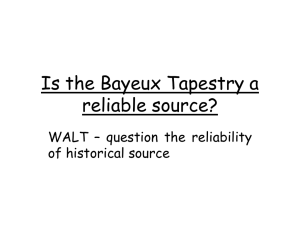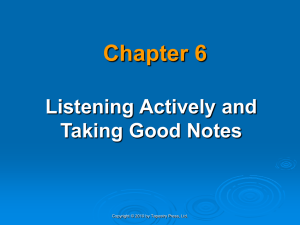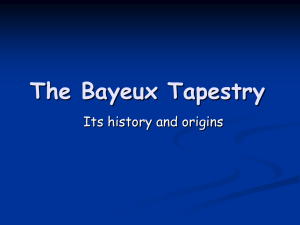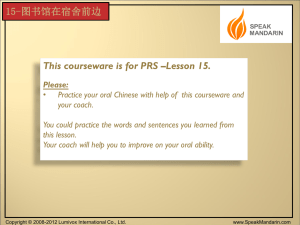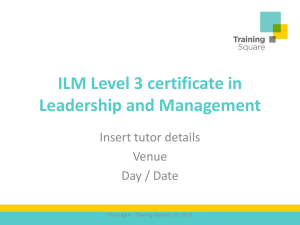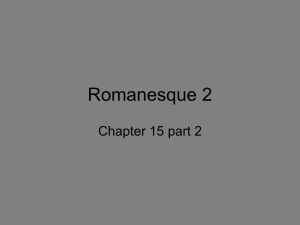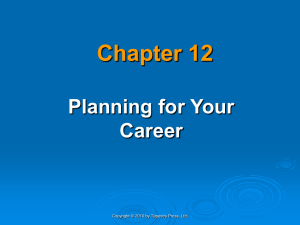Chap 7 Learning to Think Critically
advertisement
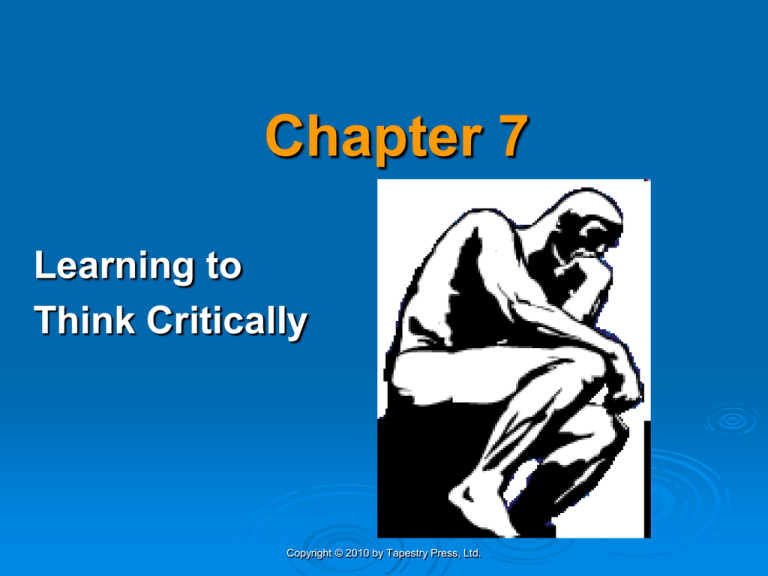
Chapter 7 Learning to Think Critically Copyright © 2010 by Tapestry Press, Ltd. Think About It We think so because other people all think so; or because—or because—after all we do think so; or because we were told so, and think we must think so; or because we once thought so, and think we still think so; or because, having thought so, we think we will think so… –—Henry Sidgwick Copyright © 2010 by Tapestry Press, Ltd. T h e T h i n k e r Copyright © 2010 by Tapestry Press, Ltd. T h e T h i n k e r 2 Copyright © 2010 by Tapestry Press, Ltd. Purpose of This Chapter To equip you with basic critical thinking skills that will help you learn and understand more in school, develop valuable job skills, and manage your life more effectively. This chapter gives you opportunities to apply thinking skills to issues you care about. Copyright © 2010 by Tapestry Press, Ltd. Learning Outcomes 1. 2. 3. 4. 5. Become a critical thinker. Apply the guidelines and tools for critical thinking in school, work, and in your personal life. Apply critical thinking while you reading. Think critically about the media. Appreciate the value of critical thinking. Copyright © 2010 by Tapestry Press, Ltd. Critical thinking is not necessarily being “critical” or negative. 1. 2. In fact, a more accurate term would be evaluative thinking. The result of evaluation can range from positive to negative, from acceptance to rejection, or anything in between. Copyright © 2010 by Tapestry Press, Ltd. Critical Thinking Is: 1. 2. 3. 4. 5. 6. 7. 8. Asking Why? Why not? How? Testing motives, bias, incompleteness Deals with alternative explanations Formulation and testing of hypotheses If … then statements, and conditions Looking for mismatches Pattern recognition Analysis and synthesis Copyright © 2010 by Tapestry Press, Ltd. Critical thinking skills help you: 1. 2. 3. Avoid passively accepting the beliefs of others—instead you think about/analyze them. Avoid muddling through life, college, or work—instead you seek the best solutions. Learn to gather information, determine its relevance, and evaluate different perspectives on issues. Copyright © 2010 by Tapestry Press, Ltd. Exercise 7-1: Qualities of a critical thinker 1. 2. 3. 4. Exercise 7-1 in the text listed 9 qualities of a critical thinker. Write down 2 that you possess. Write down 2 that you would most like to improve. Exchange this information with a closeby classmate. Copyright © 2010 by Tapestry Press, Ltd. Tools for Critical Thinking 1. Gather information 2. Analyze it 3. Draw conclusions In the next slides we will look at each of these tools. Copyright © 2010 by Tapestry Press, Ltd. 1. Tools for gathering information a. Ask others for their viewpoints. Class viewpoints What are the best ways to lose weight? . . . and Why? Copyright © 2010 by Tapestry Press, Ltd. 1. More tools for gathering information a. Brainstorm the possibilities. Class discussion OK, so you want to determine the ideal spouse or life partner. Let’s brainstorm what are the characteristics of this ideal person? Notes: Avoid critical evaluation during the brainstorming. Brainstorming allows us to produce a free flow of ideas and even piggyback on ideas. Critical evaluation comes later when we want to narrow ideas. Copyright © 2010 by Tapestry Press, Ltd. 1. More tools for gathering information continued b. Read a variety of viewpoints on the subject. Activity Google “weight loss strategies” and see how many different viewpoints you get. Copyright © 2010 by Tapestry Press, Ltd. 1. More tools for gathering information continued c. Conduct a survey. Activity Conduct a campus opinion survey. Let’s all determine what we want to survey and learn, and then construct our question(s). Copyright © 2010 by Tapestry Press, Ltd. 1. More tools for gathering information continued d. Observe and record your observations. Activity set up a situation where you can observe a response to a sign on campus and record the different behavioral responses you observe. Example Place a sign on campus that says: “Hate in your heart will consume you.’’ (from a Will Smith song) Copyright © 2010 by Tapestry Press, Ltd. 2. Tools for analyzing the information or data a. Compare positions and views. What are the differences and similarities? Activity Let’s compare the class viewpoints on the best way to lose weight. Note differences Note similarities Copyright © 2010 by Tapestry Press, Ltd. 2. Tools for analyzing the information or data continued b. Examine the pros and cons of your brainstorming. Use a plus (P), minus (M), and interesting (I) evaluation system to evaluate each idea. Activity Let’s examine the pros and cons of the list of characteristics of the ideal spouse or life partner to determine the most important to the class. Copyright © 2010 by Tapestry Press, Ltd. 2. Tools for analyzing the information or data continued c. As you read other viewpoints, read with a questioning attitude and look for answers. “Hmm, if that’s true then . . .” try to distinguish fact from opinion. detect biases or prejudices—yours and the author’s. Copyright © 2010 by Tapestry Press, Ltd. 2. Tools for analyzing the information or data continued Emphasize analysis—taking things apart. Emphasize synthesis—putting things together. Must think both ways. Otherwise, we are “half wits” Think of an example of the above. Copyright © 2010 by Tapestry Press, Ltd. 2. Tools for analyzing the information or data continued d. Interpret your findings. What do your statistics mean? (Explain the data.) Answer the above in terms of your survey results. Copyright © 2010 by Tapestry Press, Ltd. 3. Tools for drawing conclusions and reassessing a. b. c. Draw reasonable conclusions based on your comparisons and data analysis. Apply (try out) your decision/conclusion. Evaluate. How well does your conclusion hold up? Copyright © 2010 by Tapestry Press, Ltd. 3. Tools for drawing conclusions and reassessing continued Reassess as new information becomes available. e. Make modifications as necessary. f. Keep reassessing and adjust as necessary. Think of a time when you reassessed and changed your stand on an issue. d. Copyright © 2010 by Tapestry Press, Ltd. Basic Guidelines for Critical Thinking Class Reflection: As we cover each of the 13 guidelines for critical thinking from the text, 1. stop and reflect on an example of when you used each of the guidelines. 2. and think about why this action was valuable. Copyright © 2010 by Tapestry Press, Ltd. Basic Guidelines for Critical Thinking 1. 2. 3. 4. Accept and learn to appreciate that diversity of opinions exists. Ask questions to learn more and to clarify. Learn to live with uncertainty. Avoid making inaccurate generalizations or stereotypes. Copyright © 2010 by Tapestry Press, Ltd. Basic Guidelines for Critical Thinking continued 5. 6. 7. 8. 9. Challenge conventional wisdom. Evaluate your opinions as well as the expert’s opinion. Allow yourself to disagree with others. Don’t allow yourself to be overcome by solution killers. Use brainstorming to jump-start ideas. Copyright © 2010 by Tapestry Press, Ltd. Basic Guidelines for Critical Thinking continued 10. 11. 12. 13. Be focused but flexible. Be aware of what you know and what you don’t know. Withhold judgment until the evidence convinces you. Be imaginative and practical. Copyright © 2010 by Tapestry Press, Ltd. Critical Reading At the heart of critical reading is questioning. Questioning helps us probe. Think about it When is critical reading important to you? Copyright © 2010 by Tapestry Press, Ltd. Small Group Activity (based on assigned new articles) 1. 2. Each group will discuss their news article and Use the Ten Critical Thinking Questions to Probe Your Reading from the next 3 slides to discuss and critique your article. Copyright © 2010 by Tapestry Press, Ltd. Ten Critical Thinking Questions to Probe Your Reading 1. 2. 3. What’s the author’s opinion? What’s the author’s purpose? What’s the author’s mode of discourse? Narrative discourse tells a story—it details a sequence of events. Descriptive discourse—describes something. Persuasive discourse—is a piece of writing that tries to argue a point or to otherwise persuade you to a certain way of thinking. Expository discourse—explains something; the mode of discourse of this book is expository. Copyright © 2010 by Tapestry Press, Ltd. Ten Critical Thinking Questions to Probe Your Reading continued 4. 5. 6. 7. Is the author objective or biased? Does the author provide support for his/her views and statements? What are the author’s credentials? How good are the author’s sources? Copyright © 2010 by Tapestry Press, Ltd. Ten Critical Thinking Questions to Probe Your Reading continued 8. 9. 10. What’s the other side of this issue? What is the author’s thought pattern? Ask questions of yourself as well. Copyright © 2010 by Tapestry Press, Ltd. Think Critically about the Media The same critical thinking tools that you applied to problem solving, decision making, and reading can be applied to the media messages you encounter every day. Copyright © 2010 by Tapestry Press, Ltd. Tips for Thinking Critically About Advertising It uses bias to influence your opinion. It presents information in a way that they think will make you want to buy their products. It likes to tell you what to think. It carefully use direct and simple words and phrases. “Just do it!”—a message of freedom from Nike. Copyright © 2010 by Tapestry Press, Ltd. Tips . . . for Thinking Critically About the Media 1. 2. 3. 4. Watch out for the difference between fact and opinion. Remember, anything that can be proved or verified is a fact. Learn to be aware of editorial viewpoints in newspapers and magazines. What emotional response is the advertiser trying to get from you? Watch television commercials with a sharp eye. Because commercials are on TV, they can dramatize their pitch to viewers. How realistic are the ads? Copyright © 2010 by Tapestry Press, Ltd. Key Chapter Points 1. Critical thinking is essentially evaluating ideas, thinking for yourself, and active thinking— asking questions about the information before you accept it. 2. The result of critical thinking is learning more understanding more remembering it longer (which is obviously useful for college, as well as in your work and personal life) Copyright © 2010 by Tapestry Press, Ltd. Key Chapter Points continued 3. Critical thinking helps you think harder about issues and helps you stay more flexible because you realize that many issues have no single answer. 4. Critical thinking is a valuable tool that’s worth all your efforts to master. Copyright © 2010 by Tapestry Press, Ltd. Think Critically About Your Self-Talk “Success is a mental program. Deprogram your negative mind scripts and re-write your own positive scripts to serve your best interest.” —Med Yones Hmm. Reflect on that! Copyright © 2010 by Tapestry Press, Ltd. Sometimes I can’t think anymore! Copyright © 2010 by Tapestry Press, Ltd. “Follow the path of the unsafe, independent thinker. Expose your ideas to the danger of controversy. Speak your mind and fear less the label of crackpot than the stigma of conformity.” —Thomas J. Watson, Sr. Founder of IBM (1874–1956) Copyright © 2010 by Tapestry Press, Ltd.
